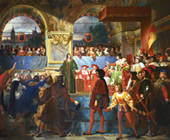 Written constitutions are relatively modern inventions. In fact, the American Constitution was one of the first to be put in print. Prior to that time, historians explain, all law was considered sacred and untouchable. Indeed most eighteenth-century Americans before the Revolution would have understood the term constitution to be the sum of a nation’s common and statutory laws, political forms and customs.
Written constitutions are relatively modern inventions. In fact, the American Constitution was one of the first to be put in print. Prior to that time, historians explain, all law was considered sacred and untouchable. Indeed most eighteenth-century Americans before the Revolution would have understood the term constitution to be the sum of a nation’s common and statutory laws, political forms and customs.
 “Only the activities of the absolutist States which succeeded the medieval and representative States, and which ruthlessly encroached upon private rights, explain the demand for constitutionally protected fundamental rights,” writes historian Fritz Kern (Kingship and Law,186).
“Only the activities of the absolutist States which succeeded the medieval and representative States, and which ruthlessly encroached upon private rights, explain the demand for constitutionally protected fundamental rights,” writes historian Fritz Kern (Kingship and Law,186).
Is Technology Ruining Your Life? Take A Quick Quiz To Find Out By Clicking Here.
Before modern times, most people would agree with Lord Viscount Bolingbroke’s well-known definition of a constitution, which he laid out in 1735: “By Constitution, we mean, whenever we speak with propriety and exactness, that assemblage of laws, institutions, and customs, derived from certain fixed principles of reason…that compose the general system, according to which the community hath agree to be governed.” (as quoted in Stephen M. Klugewicz and Lenore T. Ealy, History, on Proper Principles, Essays in Honor of Forrest McDonnald, ISI Books, Wilmington, Del., 2010, p. 5)


